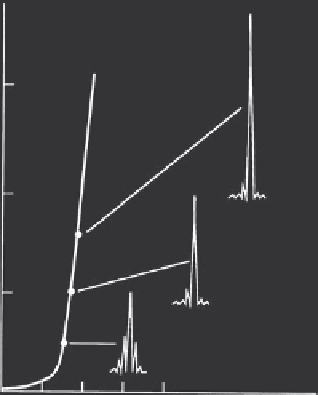Biomedical Engineering Reference
In-Depth Information
the index-guided laser. To provide a controlled frequency of operation, that
is, linewidths in the 0.5-0.8 Å range, the laser structure can be fabricated
to incorporate a grating for DFB. A typical grating spacing is in the 3450-
3476 Å range. The grating is constructed in such a way that it suppresses
unwanted wavelengths while selecting a chosen wavelength. The wave-
length selective grating is used in place of facets, which are not frequency
selective, to provide the optical feedback necessary for lasing. In the DFB
laser, the wavelength of emission is somewhat affected by the laser gain
curve [33] and more specifically by the grating spacing. Single-mode opera-
tion depends on the fact that the frequency spacing between adjacent modes
is large and the grating can significantly reduce the gain at the unwanted
frequency.
DFB laser structures that operate in the 1.3-1.55 μm range are commer-
cially available. Very short grating spacing is required for operation around
0.83 μm, and developments are more limited due to manufacturing difficul-
ties. Lattice damage often occurs during the masking or chemical etching
or ion beam sputtering grating fabrication processes, lowering the optical
quality of subsequently grown layers.
Figure 4.19 shows the CW characteristics of a 120 μm buried heterostruc-
ture GaAs laser [34]. Some observations include the low threshold current
and the single-mode spectral output at an optical output of 1.3 mW. The char-
acteristics of a similar 250 μm buried heterostructure GaAs laser are shown
in Figure 4.20.
Note that a higher threshold current is required and that single-mode
operation was not achieved. Figure 4.21 depicts the time-averaged spectrum
3
2
1
FIGURE 4.19
CW light versus current and spectral char-
acteristics of a GaAs laser whose cavity
length is 120 μm.
5
10
15 20
Current (mA)

Search WWH ::

Custom Search